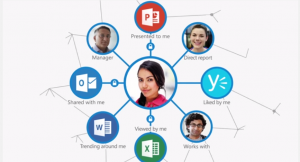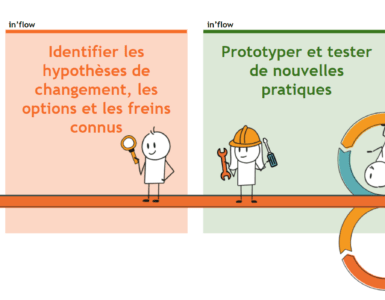Knowledge management has raised so many different definitions that we do not really know where to settle in between managing, planning, spreading or collecting knowledge within organizations. What we sure know is that it’s all about leveraging information and knowledge within organizations and making users’ everyday life simplier through intuitive systems enabling that.
“Managing” knowledge is making sure that employees will not waste time searching and digging up existing content, which can lead to a tremendous decrease in the overall organization efficiency. If you still cannot figure it out, well, look around you and you’d be quite surprised with how much the “KM Trend” has already spread all over.
Is Knowledge Management the new black?
You’d be surprised to see how ancient this function is. You may associate it to a bunch of new modern roles closely linked to digital but in fact, encourging knowledge sharing has been dully practiced back in the days. We particularly owe this to a worldwide figure in the chocolate industry: Edward Cadbury (yummylicious!). Back in the 20th century, the Cadbury family managed to turn a small chocolate business into a global leader through a prestigious knowledge management model. Edward was one of these visionairies who saw in his employees – and acknowledged it – a huge potential in knowledge creation. His methods were based on suggestion schemes ending up being vastly promoted, if they were to feed the organization’s efficiency. This guy literally pioneered participative management and innovation-based initiatives coming from the teams.

Back in 2015 and in the IT motherland, knowledge management has been closely aligned with collaboration strategies, especially with what the market’s offering in terms of tools, softwares and integrated systems. It is quite difficult to imagine one without another and that is exactly what Microsoft realized when designing Office 365 or SharePoint. They got it right and they know they have to keep targetting organizations using their routine messages such as “be knowledgable to innovate”, “drive knowledge to create value” etc.
Of course knowledge management has to be carefully handled: some company cannot decide to “go for it” without strong KM leaders who will have both a wide overview of the best solutions of the market and a meticulous ability to tackle a specific KM issue and choose the appropriate tool. His/her role is also to fit his colleagues’ expectations through raising a more efficient use of resources and this involves developing a more powerful way of searching. In that sense, the IT market has to adapt because people now want fast, easy, intuitive and good-looking.
Fortunately, your old mate Microsoft is here and it’s putting huge money and ensuring you have the best tools to share, learn and search happily ever after.
Now Office 365’s investment is well secured, Microsoft recently announced the release of “NextGen portals” and more precisely a John Doe portal with blogging functionalities – an example of a “all you need in one tool” portal. You can have fun and create microsites homepages etc – bearing in mind that you won’t have much control over functionalities or final design. Take it or leave it.
Look at this video! Wicked. Cool user experience to come.
But why, why, I mean why would we need all that bunch of stuff? Well, actually, Microsoft has carefully thought about each one of you when designing the whole glorious concept: whether you’re Harry, the not-so-very-tech-native 56 years old guy from HR who needs to publish a note on how the new travels booking platform works, whether you’re Sophie, brand new tech savy legal account manager who wants to look at legal materials regarding her company for a specific case or William that 41 years old M&A teammate who recently created a workspace for his worldwide project to exchange the latest calendar of actions on a PPT doc.
Microsoft has already gone further when introducing Delve, that fascinating Pinterest-like dashboard using machine learning and artificial intelligence to curate the most relevant information that may interest you. That big tool helps you in your search adventure. Just type your key work on the platform and it’ll suggest you a wide range of results going from Word or PPT docs to people or communities, as long as it has the right read rights assigned.
Tic, tac, tic toc…guess what? You are being watched. Again!
Yeah of course, Delve – as a big Microsoft jackpot newborn – has been well received in the press and by most companies generally speaking, as an incredible / mind-blowing / visionary, waaaayy too cool experience. That brillant Mr Delve is indexing, analyzing, scoping every single of your move within your company: emails, meetings, contact cards, numbers, social networks, groups of discussions, documents, confidential info etc. This is quite an intrusive approach but hey, apparently it’s A-MA-ZING. Let’s just hope your company implementing it has a clear governance, good tutorials to teach users how to make their content not on the public place and a good security awareness.
Last but not least, just like Delve or Office 365, Microsoft has made some big anouncements last month about SharePoint 2016 and how super awesome it’s going to be: a cleaner interface, plenty of bright and shiny features, a hybrid search, a better integration of Yammer…
Is Microsoft seriously, constently just re-inventing Knowledge Management, or what?
Big question here. Well let’s say that for the past 10 years, Microsoft has clearly been focused on the users’ ability of easily collating knowledge and information, making it valuable and available to others at the right time. Looking back to the 2000’s, they clearly stated that their different offers will target Knowledge Management highlighting the key role of the future “knowledge worker”, people like you and me, people capitalizing, searching and looking how to best enhance content in organizations. They smartly assumed that knowledge curating will be the Deal of the decade and they constantly find the right way to re-think their tools so that they fit companies’ new way of working.
That long lasting love story between Microsoft and Knowledge Management is a profitable one and Satya Nadella is absolutely grateful it exists (cf. the 2014 annual report highlights a revenue of more than $86 billion, with a gross margin of nearly $60 billion).
Knowledge is power
Obviously, not every company has the “right” background to welcome Microsoft tools maturity (i.e a technology jungle).
Also, let’s not forget that knowledge sharing is a culture, and fear of innovation is also a state of mind and it’s taking a great deal of digital maturity to have Offices 365 or SharePoint deployed within a company, keeping in mind that if adoption there is, it will take time to reach out to benefits listed by Microsoft, such as:
– improved decision-making
– more skilled employees
– cycle-time reductions, better resource returns,
– higher product satisfaction indexes
– increased employee education levels
That’s a long list and probably way too general but hey, let’s admit that those reasons have proved to be convincing enough for companies to enter the big Microsoft Kingdom to magnify their employees respective experiences! Wait for the next big announcement to come, it’s just around the corner and it’s full of enchantment.





